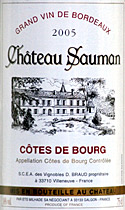I got a little surprise when I pulled the long natural cork from this bottle of bargain-priced Bordeaux: An inky black sludge coated the inner end of the cork with a shiny goo, and more of the same muddy stuff filled up the neck.
Ick.
Perhaps surprisingly, the wine seemed undamaged, although the task of cleaning up the mess took the edge off the customary ritual of pulling cork and pouring.
I scooped out the sludge with a fingertip and wiped the glass clean with a paper towel, noting that the goo painted my hands with bold blackish-purple stripes. Happily, it was water-soluble, and washed right off.
For the sake of science (and knowing the stuff to be a harmless mix of tartrates, phenolic polymers and perhaps microscopic bits of fruit and yeast), I took a tiny taste. It was gritty, astringent, with a vaguely winey flavor. Not disgusting, but I wouldn't call it palatable either. You don't really want it in your glass.
Sediment of this type normally collects, quietly and out of the way, on the down side of a bottle stored horizontally under cool cellar conditions. You can get a good bit of it in an older red wine, but it's unusual to see a heavy deposit in the business end of a three-year-old bottle.
My guess: The wine was exposed to extreme cold in shipment or storage, prompting it to "throw" an unusual amount of young sediment. The wine was in cartons stored neck down (a common practice), so the sediment collected on the inner end of the cork and inside the neck.
Without finding another bottle of the same wine without sediment, it's not possible to say with certainty whether its flavor was affected. But I'm happy to report that it seemed fine, once the sediment was removed, with good fruit and acid in balance, firm tannins and intriguing minerality. That's a lot of Bordeaux for 10 bucks, even if it did come with an unwanted bonus.
The wine, 2005 Chateau Sauman from Vignobles D. Braud, is a Cotes de Bourg, made from vineyards around the village of Bourg on the right bank of the Gironde estuary, just across the water from the fabled Margaux appellation in the Médoc. Bourg wines are generally made with Merlot predominating, and - like its neighbor Blaye - it's a name to watch for if you're seeking decent, affordable Bordeaux as we are in ths month's Wine Focus.
 Chateau Sauman 2005 Cotes de Bourg ($9.99)
Chateau Sauman 2005 Cotes de Bourg ($9.99)Very dark ruby with reddish-orange glints. Currants and dusty red clay, a lot of minerality on the nose and palate. There's good, juicy red fruit, too, apparently not compromised by the large amount of sediment in this bottle; perceptible but smooth tannins to provide structure. Good now with food, with sufficient fruit and balance to carry it through five years or so while the tannins resolve a bit. U.S. importer: Ex Cellars Wine Agencies Inc., Solvang, Calif. (March 2, 2008)
FOOD MATCH: Beef and lamb are perhaps the classic meat pairings with Bordeaux, but fresh, natural pork chops, pan-seared with onions and garlic, came right up to meet it, too.
VALUE: In today's market, you won't find better Bordeaux at $10.
WHEN TO DRINK: A sturdy, tannic Bordeaux like this, even a modest wine from a satellite appellation, should cellar well for at least a few years.
WEB LINK:
The Chateau Sauman Website appears to be available in French only:
http://www.chateausauman.com/index.htm
FIND THIS WINE ONLINE:
Wine-Searcher.com yields only limited sources for Chateau Sauman:
http://www.wine-searcher.com/find/Sauma ... g_site=WLP
Try asking your better local retailers, or contact the U.S. importer for information about retail sources:
http://www.excellars.com/About.html

